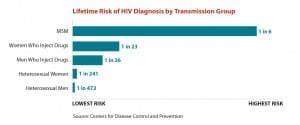Update on HIV from Centers for Disease Control
From Medical Institute for Sexual Health:
The above graphic (shown here below) was released this week from the CDC, as the 2016 Conference on Retroviruses and Opportunistic Infections took place in Boston, Massachusetts. While other graphics focused on racial groups and geographic regions, this particular graphic demonstrates behavioral factors that put individuals at high risk for acquiring HIV. The most risky behavior is MSM, (men having sex with men), followed by women who inject drugs, then men who inject drugs. 1
In the CDC’s “Sexually Transmitted Diseases Treatment Guidelines, 2015”, the priorities of prevention begin with vaccine. Since there is no vaccine for HIV, the next prevention strategy is abstinence and reduction of number of sex partners. The following statement is included in this section of the Guidelines: “The most reliable way to avoid transmission of STDs is to abstain from oral, vaginal, and anal sex or to be in a long-term, mutually monogamous relationship with a partner known to be uninfected.” The third prevention strategy is male condoms.2
This week’s press release states: “CDC’s High Impact Prevention approach focuses on delivering the most effective prevention strategies – including HIV testing, ongoing care and treatment for people living with HIV, pre-exposure prophylaxis (PrEP, a daily anti-HIV pill for high-risk uninfected people) and condoms.”1 Interestingly, there is no mention of abstinence or reduction of sexual partners.
The CDC’s “HIV/AIDS Preventive Services” (indicating services that are payable by the Affordable Care Act, Medicare and Medicaid), also lists HIV testing as the first line of prevention (Grade A). The second line of prevention (Grade B) does include counseling, which allows for education, skills training, and guidance on how to change sexual behavior. 3&4 “High intensity counseling” includes two individual 20 to 30 minute, face to face counseling sessions annually.
Research has clearly identified behaviors that put individuals at high risk for acquiring HIV. In order to avoid the risk of HIV, risky behaviors need to be avoided. Providing IV drug users with clean needles, or with prophylactic anti-HIV daily medications, may reduce the risk for HIV, but is it our best answer? How likely is an IV drug user to be consistent in taking a daily medication? In the same way, providing testing and condoms for individuals with multiple sex partners may reduce the risk of acquisition of HIV (70% to 80%), but only if the condoms are used correctly and consistently with each sexual encounter. Is this our best answer? Do we put all sexually active people in non-monogamous relationships on PrEP?






